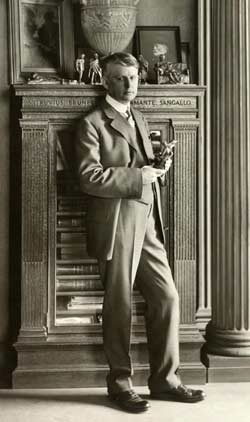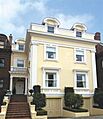Willis Polk facts for kids
Quick facts for kids
Willis Polk
|
|
|---|---|
 |
|
| Born |
Willis Jefferson Polk
October 3, 1867 Jacksonville, Illinois, U.S.
|
| Died | September 10, 1924 (aged 56) San Mateo, California, U.S.
|
| Resting place | Santa Clara Mission Cemetery |
| Nationality | American |
| Occupation | Architect |
Willis Jefferson Polk (born October 3, 1867 – died September 10, 1924) was a famous American architect. He is best known for the many buildings he designed in San Francisco, California. For ten years, he worked as the main representative for a big architecture company called D.H. Burnham & Company on the West Coast. In 1915, Willis Polk helped lead the group that planned the buildings for the Panama–Pacific International Exposition, a huge world's fair.
Contents
Willis Polk's Early Life and Learning
Willis Polk was born in Jacksonville, Illinois on October 3, 1867. His father, Willis Webb Polk, was also an architect and builder. Willis was the oldest of four children.
In 1873, his family moved to Saint Louis, Missouri. By 1881, they moved again to Hope, Arkansas. Willis Jr. started learning about architecture by working with his brother Daniel in his father's office.
In 1885, the Polk family moved to Kansas City. There, Willis's father helped him get a job as a "draftsperson" at a company called Van Brunt & Howe. A draftsperson draws detailed plans for buildings. A few years later, Willis Jr. went to New York City to study architecture more at Columbia University.
Willis Polk's Career as an Architect
Willis Polk worked with several important architects early in his career. These included McKim, Mead & White and Bernard Maybeck. In 1889, Polk joined a firm in New York and moved with them to San Francisco. He later took over a big project, the Ferry Building, after the firm's owner passed away.
During these years, Polk became a strong supporter of good architectural design. He even started a magazine called Architectural News to share his ideas. He also wrote articles for a San Francisco magazine called The Wave. Sometimes, his comments were very direct, which could upset other architects.
In 1894, the Sierra Club, a group focused on protecting nature, chose a design by Willis Polk for their new logo. They used his design for many years.
Facing Challenges and Finding Success
Willis Polk had some tough times and even declared bankruptcy in 1897. But in 1899, he got a new chance. He became partners with George Washington Percy in an architecture firm. Polk focused on designing buildings, while Percy handled the business side. This partnership helped Polk pay off his debts and work on larger buildings.
In 1901, Polk traveled to Europe and Chicago. In Chicago, he met a famous architect named Daniel Burnham. From 1903 to 1913, Polk worked as Burnham's main representative on the West Coast. During this time, Polk designed some of his most famous buildings. One was the Merchants Exchange Building, which was the tallest building in San Francisco when it was finished in 1903.
The 1906 San Francisco earthquake caused a lot of damage but also created many chances for Polk to design new buildings. He was part of a group of leaders who planned to rebuild San Francisco into a world-class city. Polk tried to convince city officials to use Daniel Burnham's big plan for the city.
Designing Iconic San Francisco Buildings
By 1910, Willis Polk was known as one of the most important architects and city planners in San Francisco. He designed the Hobart Building, which became the tallest building in the city in 1914.
In 1915, Polk led the committee that planned the buildings for the Panama–Pacific International Exposition. After the fair, Polk worked hard to save the beautiful Palace of Fine Arts, designed by Bernard Maybeck.
One of Polk's most important designs was the Hallidie Building in 1916. This building had a glass front, which was very new and modern for its time. It helped inspire how skyscrapers would be built later. Many people say it is one of San Francisco's most important buildings.
Willis Polk was a very flexible architect. He was good at mixing classic styles with nature. He was also known for designing elegant homes, especially large mansions, for wealthy families in San Francisco.
After World War I, Polk's work slowed down a bit. He helped design the War Memorial Opera House and Veterans Building, which are part of San Francisco's Civic Center. In 1917, Polk designed several single-family homes on Mason Street in the fancy Nob Hill area of San Francisco.
Willis Polk's Legacy and Death
Willis Polk passed away at his home in San Mateo on September 10, 1924. He was 56 years old. He is buried in the Santa Clara Mission Cemetery in Santa Clara, California. After he died, his stepson, Austin P. Moore, continued to run his architecture business for a few more years.
Some of Willis Polk's drawings and papers are kept at the University of California, Berkeley. Other collections of his work can be found at the California Historical Society and the Smithsonian Archives of American Art.
Notable Buildings Designed by Willis Polk
- Le Petit Trianon, Cupertino, California (1892)
- Valentine Rey house, Belvedere, California (1893)
- Robert Louis Stevenson Memorial, San Francisco (1897)
- First Church of Christ Scientist, San Jose, California (1904)
- Merchants Exchange Building, San Francisco (1904)
- Reconstruction of the James C. Flood Mansion, San Francisco (1907)
- Reconstruction of the old Chronicle Building, San Francisco (1907)
- Reconstruction of the Mills Building and Tower, San Francisco (1908)
- Sunol Water Temple, Sunol, California (1910)
- Western Pacific Passenger Depot, Sacramento, California (1910)
- St. Mark's Episcopal Church (Berkeley, California) (1911)
- Pacific Gas & Electric Company, River Station B, Sacramento, California (1912)
- Hobart Building, San Francisco, California (1914)
- Filoli Estate, Woodside, California (1915–1917)
- Hallidie Building, San Francisco (1917–1918)
- Reconstruction of Mission San Francisco de Asís (1917)
- St. Francis Yacht Club Clubhouse, San Francisco (around 1924)
- Beach Chalet, Golden Gate Park, San Francisco (1925)
- Kezar Stadium, Golden Gate Park, San Francisco (1925)
- Redesign of McCullagh–Jones House, Los Gatos, California (1931)
- Spring Valley Water Company, San Francisco, California
- House at NE corner of 9th & Dolores, Carmel-by-the-Sea, California (1903)
- 86 Sea View, Piedmont, California
- 22 Roble Road, Berkeley, California
- 2550 Webster Street, San Francisco, California
- Townhouses at 831-849 Mason Street, San Francisco, California
Images for kids



